#and not that herodotus had feathers
Quote
To the north of the Arimaspi were the Rhipean Mountains and a region called Pterophorus because of the feather-like snow, which continuously fell there. This is in all probability a reference to Herodotus’ feathers which the Scythians say fill the air and make it impossible to traverse, or even to see, the more northerly part of the continent (Herodotus 4.31). These feathers may be a reference to the swan which Apollo rode or to the swans which pulled Apollo’s chariot to the land of the Hyperboreans in Alcaeus’ text.
Timothy Bridgman, Hyperboreans: Myth and History in Celtic-Hellenic Contacts
#timothy bridgman#hyperboreans#apollon#swans#snow#ancient greece#hellenic deities#quotes#feathers#to be clear: herodotus' feathers meaning they are feathers he mentioned#and not that herodotus had feathers#though I suppose we can't prove herodotus didn't have feathers#I mean I've never seen him. have you?#anyway please enjoy the image of swanfeather snow
3 notes
·
View notes
Note
Do we have a Phonenix yet in the menagire? We need one.
Phoenix!Desmond, probably looking like a normal bird for the most part, and stays with Sef when they go after the mongols (Altair probably thinks he's getting too old he looked a bit ratty lately) and takes the hit when Swami tries to kill him.
Idk whether to have this crack or angest with them thinking Desmond died, had a chick, and was apparently a female bird the entire time.
Okay, so I was checking the Phoenix wiki page for any information if it would be possible that Altaïr would know what a phoenix is and there’s this part written by Herodotus (yes, Kassandra’s Herodotos)
[The Egyptians] have also another sacred bird called the phoenix which I myself have never seen, except in pictures. Indeed it is a great rarity, even in Egypt, only coming there (according to the accounts of the people of Heliopolis) once in five hundred years, when the old phoenix dies. Its size and appearance, if it is like the pictures, are as follow: The plumage is partly red, partly golden, while the general make and size are almost exactly that of the eagle. They tell a story of what this bird does, which does not seem to me to be credible: that he comes all the way from Arabia, and brings the parent bird, all plastered over with myrrh, to the temple of the Sun, and there buries the body.
… which may be a reference to Bennu, the Egyptian deity connected to the sun, creation, and rebirth.
So Altaïr would meet him during his travels with Maria and he just stays. They assume he’s an exotic bird (or eagle), maybe a native to one of the places Altaïr and Maria visited.
Altaïr never told them that the bird flew into his room one night and began to chirp at him as if trying to tell him something. He also tried to tap the Apple but all it did was glow a bit.
The bird had been quite annoyed by it and began to hit it with his talons so quickly the Apple had a taptaptaptaptap sound rapidly before Altaïr could take the Apple.
After that, the bird just decided to sit on Altaïr’s shoulder when he left his room the following morning and Maria assumed he had bought the bird yesterday when they went their separate ways.
Her guess sounded so much better than the truth which was Altaïr spent the entire day yesterday holed up in his room, writing letters to be sent back to Masyaf as part of his deal with Malik in exchange for letting him go on this trip (which was to send letters detailing the geopolitical situations of the places he travels to with suggestion on what the Brotherhood should do in those parts… if they could do anything).
So nobody ever questioned the mentor’s newly acquired bird (except Malik but Malik had been more focused on the ex-Templar that Altaïr brought to Masyaf and married).
Then Darim and Sef were born and the bird (named Desmond because Altaïr thought of the name first when Maria asked what the bird’s name was) usually stayed with the children, letting out loud screeching cries whenever one of the two children were doing something they shouldn’t do.
When they got older, Darim and Sef learned the word ‘bribe’ and how Desmond can be easily bribed to look the other way in favor of delicious food.
Desmond stayed in Masyaf though, regardless if Altaïr or any of his sons left for a mission or to travel to a bureau. At some point, the bird had become a symbol of Brotherhood with its gold and red plumage.
So when Altaïr left with Maria and Darim to take down Genghis Khan, it was only natural for Desmond to stay with Sef in Masyaf.
Altaïr had been a bit conflicted though as Desmond’s feathers had grown quite… dull and he was moving slower than usual.
Maria and Malik both told them that Desmond was growing old and maybe it was time but the Ibn-La'Ahad boys refused to believe that.
Darim also believed that they might find medicine in one of the camps of the Mongols as they have been to many lands.
So when Desmond flew to protect Sef and got stabbed on the chest by Swami, Swami screamed as Desmond became shrouded in flames.
Swami burned as well and Sef could only watch in horror as white hot flames consumed the both of them.
Swami was left as a corpse charred beyond recognition.
While Desmond…
Only ashes remained…
And from those ashes…
Sef heard a small chirp.
As a little chick with red and gold plumage poked his head out of the ashes, shaking the ash from his small body.
Sef could only stare as he asked, “Desmond?”
And the bird gave him an enthusiastic chirp while jumping.
#ngl#super tempted to make desmond a female bird and have him freak out when he suddenly plopped an egg#we can go for the ‘his ancestors get reborn too as his children’ route#and the eggs stay dormant#until the death of his ancestors#so desmond’s gonna be the mother of a flock of phoenix(es)#desmond is turned into an animal subgenre#desmond is turned into a creature subgenre#ask and answer#assassin's creed#desmond miles#teecup writes/has a plot#fic idea: assassin's creed#altaïr ibn la'ahad#sef ibn la'ahad
201 notes
·
View notes
Photo

Inmates may communicate with their friends
The other case was more annoying still. In every lazaretto is a place called the parlatorio, at which the inmates may communicate with their friends. It is very like the grating used for the same purpose at our prisons. There is a double wall of bars, with a space of six or seven feet between them; and articles are pushed backwards and forwards on boards, which run across, in boxes fixed to poles. A person in quarantine received a visit from a friend on the first day of his confinement. Laden with treasures of travel, he was exhibiting some beautiful feathers to his friend, when a sudden puff of wind dispersed the collection, and by an evil chance blew open, between the bars, into the bosom of his innocent visitor. The unfortunate wight was directly condemned. All egress was denied him; he was told that, of all things, feathers were peculiarly susceptible of plague; and he had to join his friend for the whole term of his imprisonment. In fine, the laws of quarantine appear to be the most rigid of any existing, and cannot, by any influence or interest, be evaded. This is not so much to be wondered at when the various incomes derived from enforcing-them are taken into consideration; and, indeed, this appears to be, at present, the sole cause of their continuance.
Large quantity of beasts
There was a large quantity of beasts of burden awaiting the turn-out, — camels, horses, and donkeys. The boys who attended the latter were sad young scamps — little dusky chaps, with nothing on but what seemed to be a long blue bedgown. When a stranger appeared, they caught their donkeys by the head, and backed them all in a heap against him. In vain the valet beat them furiously about the head, face, and naked legs. They only fell back for an instant, and then all returned to the charge again, shouting, “ I say, master — good jackass! ” Somehow or another, I was hustled on to one of the donkeys — I am sure I don’t know how; I never chose one — and then we set off at a quick, easy amble towards Alexandria private tour istanbul.
The road was regularly made — broad, and very level, and bordered with acacia trees; and over garden walls I saw, for the first time, the graceful date-palms and banana trees. All along the road were strings of baggage-camels — many more together than I bad seen either at Smyrna or Constantinople — with a great number of women, scantily clad, and all carrying water-jars on their heads, which they balanced wonderfully. Then we passed Cleopatra’s Needle; and then I insisted upon seeing Pompey’s Pillar before we went to the hotel, and a circuit was made accordingly. It was a very familiar object; one there could be no mistake about upon approaching. I tried to feel as other writers have felt — when, as they have affirmed, the names of Herodotus, Ptolemy, and other ancients, rose up before them, as they gazed at the pillar — but I could not; for the only names that Ponipcy’s Pillar most readily suggests, are those painted on it, in enormous letters, a foot high, visible a quarter of a mile off; and as these arc, respectively, G. Button, and W. Thompson, of Sunderland, no remarkable enthusiasm is created.
I was glad to find myself, at last, in the comfortable transit hotel at Alexandria; and looking out from my lofty bedroom into its broad bright square. Everything was sunny and cheering; new impressions, more striking even than those I had already received, were in store for me; and the next evening would find me, with a boat and crew of my own, journeying on towards the mighty Nile, with all the land of the solemn and mystic Egypt before me.
1 note
·
View note
Photo

Inmates may communicate with their friends
The other case was more annoying still. In every lazaretto is a place called the parlatorio, at which the inmates may communicate with their friends. It is very like the grating used for the same purpose at our prisons. There is a double wall of bars, with a space of six or seven feet between them; and articles are pushed backwards and forwards on boards, which run across, in boxes fixed to poles. A person in quarantine received a visit from a friend on the first day of his confinement. Laden with treasures of travel, he was exhibiting some beautiful feathers to his friend, when a sudden puff of wind dispersed the collection, and by an evil chance blew open, between the bars, into the bosom of his innocent visitor. The unfortunate wight was directly condemned. All egress was denied him; he was told that, of all things, feathers were peculiarly susceptible of plague; and he had to join his friend for the whole term of his imprisonment. In fine, the laws of quarantine appear to be the most rigid of any existing, and cannot, by any influence or interest, be evaded. This is not so much to be wondered at when the various incomes derived from enforcing-them are taken into consideration; and, indeed, this appears to be, at present, the sole cause of their continuance.
Large quantity of beasts
There was a large quantity of beasts of burden awaiting the turn-out, — camels, horses, and donkeys. The boys who attended the latter were sad young scamps — little dusky chaps, with nothing on but what seemed to be a long blue bedgown. When a stranger appeared, they caught their donkeys by the head, and backed them all in a heap against him. In vain the valet beat them furiously about the head, face, and naked legs. They only fell back for an instant, and then all returned to the charge again, shouting, “ I say, master — good jackass! ” Somehow or another, I was hustled on to one of the donkeys — I am sure I don’t know how; I never chose one — and then we set off at a quick, easy amble towards Alexandria private tour istanbul.
The road was regularly made — broad, and very level, and bordered with acacia trees; and over garden walls I saw, for the first time, the graceful date-palms and banana trees. All along the road were strings of baggage-camels — many more together than I bad seen either at Smyrna or Constantinople — with a great number of women, scantily clad, and all carrying water-jars on their heads, which they balanced wonderfully. Then we passed Cleopatra’s Needle; and then I insisted upon seeing Pompey’s Pillar before we went to the hotel, and a circuit was made accordingly. It was a very familiar object; one there could be no mistake about upon approaching. I tried to feel as other writers have felt — when, as they have affirmed, the names of Herodotus, Ptolemy, and other ancients, rose up before them, as they gazed at the pillar — but I could not; for the only names that Ponipcy’s Pillar most readily suggests, are those painted on it, in enormous letters, a foot high, visible a quarter of a mile off; and as these arc, respectively, G. Button, and W. Thompson, of Sunderland, no remarkable enthusiasm is created.
I was glad to find myself, at last, in the comfortable transit hotel at Alexandria; and looking out from my lofty bedroom into its broad bright square. Everything was sunny and cheering; new impressions, more striking even than those I had already received, were in store for me; and the next evening would find me, with a boat and crew of my own, journeying on towards the mighty Nile, with all the land of the solemn and mystic Egypt before me.
0 notes
Photo

Inmates may communicate with their friends
The other case was more annoying still. In every lazaretto is a place called the parlatorio, at which the inmates may communicate with their friends. It is very like the grating used for the same purpose at our prisons. There is a double wall of bars, with a space of six or seven feet between them; and articles are pushed backwards and forwards on boards, which run across, in boxes fixed to poles. A person in quarantine received a visit from a friend on the first day of his confinement. Laden with treasures of travel, he was exhibiting some beautiful feathers to his friend, when a sudden puff of wind dispersed the collection, and by an evil chance blew open, between the bars, into the bosom of his innocent visitor. The unfortunate wight was directly condemned. All egress was denied him; he was told that, of all things, feathers were peculiarly susceptible of plague; and he had to join his friend for the whole term of his imprisonment. In fine, the laws of quarantine appear to be the most rigid of any existing, and cannot, by any influence or interest, be evaded. This is not so much to be wondered at when the various incomes derived from enforcing-them are taken into consideration; and, indeed, this appears to be, at present, the sole cause of their continuance.
Large quantity of beasts
There was a large quantity of beasts of burden awaiting the turn-out, — camels, horses, and donkeys. The boys who attended the latter were sad young scamps — little dusky chaps, with nothing on but what seemed to be a long blue bedgown. When a stranger appeared, they caught their donkeys by the head, and backed them all in a heap against him. In vain the valet beat them furiously about the head, face, and naked legs. They only fell back for an instant, and then all returned to the charge again, shouting, “ I say, master — good jackass! ” Somehow or another, I was hustled on to one of the donkeys — I am sure I don’t know how; I never chose one — and then we set off at a quick, easy amble towards Alexandria private tour istanbul.
The road was regularly made — broad, and very level, and bordered with acacia trees; and over garden walls I saw, for the first time, the graceful date-palms and banana trees. All along the road were strings of baggage-camels — many more together than I bad seen either at Smyrna or Constantinople — with a great number of women, scantily clad, and all carrying water-jars on their heads, which they balanced wonderfully. Then we passed Cleopatra’s Needle; and then I insisted upon seeing Pompey’s Pillar before we went to the hotel, and a circuit was made accordingly. It was a very familiar object; one there could be no mistake about upon approaching. I tried to feel as other writers have felt — when, as they have affirmed, the names of Herodotus, Ptolemy, and other ancients, rose up before them, as they gazed at the pillar — but I could not; for the only names that Ponipcy’s Pillar most readily suggests, are those painted on it, in enormous letters, a foot high, visible a quarter of a mile off; and as these arc, respectively, G. Button, and W. Thompson, of Sunderland, no remarkable enthusiasm is created.
I was glad to find myself, at last, in the comfortable transit hotel at Alexandria; and looking out from my lofty bedroom into its broad bright square. Everything was sunny and cheering; new impressions, more striking even than those I had already received, were in store for me; and the next evening would find me, with a boat and crew of my own, journeying on towards the mighty Nile, with all the land of the solemn and mystic Egypt before me.
1 note
·
View note
Photo

Inmates may communicate with their friends
The other case was more annoying still. In every lazaretto is a place called the parlatorio, at which the inmates may communicate with their friends. It is very like the grating used for the same purpose at our prisons. There is a double wall of bars, with a space of six or seven feet between them; and articles are pushed backwards and forwards on boards, which run across, in boxes fixed to poles. A person in quarantine received a visit from a friend on the first day of his confinement. Laden with treasures of travel, he was exhibiting some beautiful feathers to his friend, when a sudden puff of wind dispersed the collection, and by an evil chance blew open, between the bars, into the bosom of his innocent visitor. The unfortunate wight was directly condemned. All egress was denied him; he was told that, of all things, feathers were peculiarly susceptible of plague; and he had to join his friend for the whole term of his imprisonment. In fine, the laws of quarantine appear to be the most rigid of any existing, and cannot, by any influence or interest, be evaded. This is not so much to be wondered at when the various incomes derived from enforcing-them are taken into consideration; and, indeed, this appears to be, at present, the sole cause of their continuance.
Large quantity of beasts
There was a large quantity of beasts of burden awaiting the turn-out, — camels, horses, and donkeys. The boys who attended the latter were sad young scamps — little dusky chaps, with nothing on but what seemed to be a long blue bedgown. When a stranger appeared, they caught their donkeys by the head, and backed them all in a heap against him. In vain the valet beat them furiously about the head, face, and naked legs. They only fell back for an instant, and then all returned to the charge again, shouting, “ I say, master — good jackass! ” Somehow or another, I was hustled on to one of the donkeys — I am sure I don’t know how; I never chose one — and then we set off at a quick, easy amble towards Alexandria private tour istanbul.
The road was regularly made — broad, and very level, and bordered with acacia trees; and over garden walls I saw, for the first time, the graceful date-palms and banana trees. All along the road were strings of baggage-camels — many more together than I bad seen either at Smyrna or Constantinople — with a great number of women, scantily clad, and all carrying water-jars on their heads, which they balanced wonderfully. Then we passed Cleopatra’s Needle; and then I insisted upon seeing Pompey’s Pillar before we went to the hotel, and a circuit was made accordingly. It was a very familiar object; one there could be no mistake about upon approaching. I tried to feel as other writers have felt — when, as they have affirmed, the names of Herodotus, Ptolemy, and other ancients, rose up before them, as they gazed at the pillar — but I could not; for the only names that Ponipcy’s Pillar most readily suggests, are those painted on it, in enormous letters, a foot high, visible a quarter of a mile off; and as these arc, respectively, G. Button, and W. Thompson, of Sunderland, no remarkable enthusiasm is created.
I was glad to find myself, at last, in the comfortable transit hotel at Alexandria; and looking out from my lofty bedroom into its broad bright square. Everything was sunny and cheering; new impressions, more striking even than those I had already received, were in store for me; and the next evening would find me, with a boat and crew of my own, journeying on towards the mighty Nile, with all the land of the solemn and mystic Egypt before me.
0 notes
Photo

Inmates may communicate with their friends
The other case was more annoying still. In every lazaretto is a place called the parlatorio, at which the inmates may communicate with their friends. It is very like the grating used for the same purpose at our prisons. There is a double wall of bars, with a space of six or seven feet between them; and articles are pushed backwards and forwards on boards, which run across, in boxes fixed to poles. A person in quarantine received a visit from a friend on the first day of his confinement. Laden with treasures of travel, he was exhibiting some beautiful feathers to his friend, when a sudden puff of wind dispersed the collection, and by an evil chance blew open, between the bars, into the bosom of his innocent visitor. The unfortunate wight was directly condemned. All egress was denied him; he was told that, of all things, feathers were peculiarly susceptible of plague; and he had to join his friend for the whole term of his imprisonment. In fine, the laws of quarantine appear to be the most rigid of any existing, and cannot, by any influence or interest, be evaded. This is not so much to be wondered at when the various incomes derived from enforcing-them are taken into consideration; and, indeed, this appears to be, at present, the sole cause of their continuance.
Large quantity of beasts
There was a large quantity of beasts of burden awaiting the turn-out, — camels, horses, and donkeys. The boys who attended the latter were sad young scamps — little dusky chaps, with nothing on but what seemed to be a long blue bedgown. When a stranger appeared, they caught their donkeys by the head, and backed them all in a heap against him. In vain the valet beat them furiously about the head, face, and naked legs. They only fell back for an instant, and then all returned to the charge again, shouting, “ I say, master — good jackass! ” Somehow or another, I was hustled on to one of the donkeys — I am sure I don’t know how; I never chose one — and then we set off at a quick, easy amble towards Alexandria private tour istanbul.
The road was regularly made — broad, and very level, and bordered with acacia trees; and over garden walls I saw, for the first time, the graceful date-palms and banana trees. All along the road were strings of baggage-camels — many more together than I bad seen either at Smyrna or Constantinople — with a great number of women, scantily clad, and all carrying water-jars on their heads, which they balanced wonderfully. Then we passed Cleopatra’s Needle; and then I insisted upon seeing Pompey’s Pillar before we went to the hotel, and a circuit was made accordingly. It was a very familiar object; one there could be no mistake about upon approaching. I tried to feel as other writers have felt — when, as they have affirmed, the names of Herodotus, Ptolemy, and other ancients, rose up before them, as they gazed at the pillar — but I could not; for the only names that Ponipcy’s Pillar most readily suggests, are those painted on it, in enormous letters, a foot high, visible a quarter of a mile off; and as these arc, respectively, G. Button, and W. Thompson, of Sunderland, no remarkable enthusiasm is created.
I was glad to find myself, at last, in the comfortable transit hotel at Alexandria; and looking out from my lofty bedroom into its broad bright square. Everything was sunny and cheering; new impressions, more striking even than those I had already received, were in store for me; and the next evening would find me, with a boat and crew of my own, journeying on towards the mighty Nile, with all the land of the solemn and mystic Egypt before me.
0 notes
Photo

Inmates may communicate with their friends
The other case was more annoying still. In every lazaretto is a place called the parlatorio, at which the inmates may communicate with their friends. It is very like the grating used for the same purpose at our prisons. There is a double wall of bars, with a space of six or seven feet between them; and articles are pushed backwards and forwards on boards, which run across, in boxes fixed to poles. A person in quarantine received a visit from a friend on the first day of his confinement. Laden with treasures of travel, he was exhibiting some beautiful feathers to his friend, when a sudden puff of wind dispersed the collection, and by an evil chance blew open, between the bars, into the bosom of his innocent visitor. The unfortunate wight was directly condemned. All egress was denied him; he was told that, of all things, feathers were peculiarly susceptible of plague; and he had to join his friend for the whole term of his imprisonment. In fine, the laws of quarantine appear to be the most rigid of any existing, and cannot, by any influence or interest, be evaded. This is not so much to be wondered at when the various incomes derived from enforcing-them are taken into consideration; and, indeed, this appears to be, at present, the sole cause of their continuance.
Large quantity of beasts
There was a large quantity of beasts of burden awaiting the turn-out, — camels, horses, and donkeys. The boys who attended the latter were sad young scamps — little dusky chaps, with nothing on but what seemed to be a long blue bedgown. When a stranger appeared, they caught their donkeys by the head, and backed them all in a heap against him. In vain the valet beat them furiously about the head, face, and naked legs. They only fell back for an instant, and then all returned to the charge again, shouting, “ I say, master — good jackass! ” Somehow or another, I was hustled on to one of the donkeys — I am sure I don’t know how; I never chose one — and then we set off at a quick, easy amble towards Alexandria private tour istanbul.
The road was regularly made — broad, and very level, and bordered with acacia trees; and over garden walls I saw, for the first time, the graceful date-palms and banana trees. All along the road were strings of baggage-camels — many more together than I bad seen either at Smyrna or Constantinople — with a great number of women, scantily clad, and all carrying water-jars on their heads, which they balanced wonderfully. Then we passed Cleopatra’s Needle; and then I insisted upon seeing Pompey’s Pillar before we went to the hotel, and a circuit was made accordingly. It was a very familiar object; one there could be no mistake about upon approaching. I tried to feel as other writers have felt — when, as they have affirmed, the names of Herodotus, Ptolemy, and other ancients, rose up before them, as they gazed at the pillar — but I could not; for the only names that Ponipcy’s Pillar most readily suggests, are those painted on it, in enormous letters, a foot high, visible a quarter of a mile off; and as these arc, respectively, G. Button, and W. Thompson, of Sunderland, no remarkable enthusiasm is created.
I was glad to find myself, at last, in the comfortable transit hotel at Alexandria; and looking out from my lofty bedroom into its broad bright square. Everything was sunny and cheering; new impressions, more striking even than those I had already received, were in store for me; and the next evening would find me, with a boat and crew of my own, journeying on towards the mighty Nile, with all the land of the solemn and mystic Egypt before me.
0 notes
Photo

Inmates may communicate with their friends
The other case was more annoying still. In every lazaretto is a place called the parlatorio, at which the inmates may communicate with their friends. It is very like the grating used for the same purpose at our prisons. There is a double wall of bars, with a space of six or seven feet between them; and articles are pushed backwards and forwards on boards, which run across, in boxes fixed to poles. A person in quarantine received a visit from a friend on the first day of his confinement. Laden with treasures of travel, he was exhibiting some beautiful feathers to his friend, when a sudden puff of wind dispersed the collection, and by an evil chance blew open, between the bars, into the bosom of his innocent visitor. The unfortunate wight was directly condemned. All egress was denied him; he was told that, of all things, feathers were peculiarly susceptible of plague; and he had to join his friend for the whole term of his imprisonment. In fine, the laws of quarantine appear to be the most rigid of any existing, and cannot, by any influence or interest, be evaded. This is not so much to be wondered at when the various incomes derived from enforcing-them are taken into consideration; and, indeed, this appears to be, at present, the sole cause of their continuance.
Large quantity of beasts
There was a large quantity of beasts of burden awaiting the turn-out, — camels, horses, and donkeys. The boys who attended the latter were sad young scamps — little dusky chaps, with nothing on but what seemed to be a long blue bedgown. When a stranger appeared, they caught their donkeys by the head, and backed them all in a heap against him. In vain the valet beat them furiously about the head, face, and naked legs. They only fell back for an instant, and then all returned to the charge again, shouting, “ I say, master — good jackass! ” Somehow or another, I was hustled on to one of the donkeys — I am sure I don’t know how; I never chose one — and then we set off at a quick, easy amble towards Alexandria private tour istanbul.
The road was regularly made — broad, and very level, and bordered with acacia trees; and over garden walls I saw, for the first time, the graceful date-palms and banana trees. All along the road were strings of baggage-camels — many more together than I bad seen either at Smyrna or Constantinople — with a great number of women, scantily clad, and all carrying water-jars on their heads, which they balanced wonderfully. Then we passed Cleopatra’s Needle; and then I insisted upon seeing Pompey’s Pillar before we went to the hotel, and a circuit was made accordingly. It was a very familiar object; one there could be no mistake about upon approaching. I tried to feel as other writers have felt — when, as they have affirmed, the names of Herodotus, Ptolemy, and other ancients, rose up before them, as they gazed at the pillar — but I could not; for the only names that Ponipcy’s Pillar most readily suggests, are those painted on it, in enormous letters, a foot high, visible a quarter of a mile off; and as these arc, respectively, G. Button, and W. Thompson, of Sunderland, no remarkable enthusiasm is created.
I was glad to find myself, at last, in the comfortable transit hotel at Alexandria; and looking out from my lofty bedroom into its broad bright square. Everything was sunny and cheering; new impressions, more striking even than those I had already received, were in store for me; and the next evening would find me, with a boat and crew of my own, journeying on towards the mighty Nile, with all the land of the solemn and mystic Egypt before me.
0 notes
Photo

Inmates may communicate with their friends
The other case was more annoying still. In every lazaretto is a place called the parlatorio, at which the inmates may communicate with their friends. It is very like the grating used for the same purpose at our prisons. There is a double wall of bars, with a space of six or seven feet between them; and articles are pushed backwards and forwards on boards, which run across, in boxes fixed to poles. A person in quarantine received a visit from a friend on the first day of his confinement. Laden with treasures of travel, he was exhibiting some beautiful feathers to his friend, when a sudden puff of wind dispersed the collection, and by an evil chance blew open, between the bars, into the bosom of his innocent visitor. The unfortunate wight was directly condemned. All egress was denied him; he was told that, of all things, feathers were peculiarly susceptible of plague; and he had to join his friend for the whole term of his imprisonment. In fine, the laws of quarantine appear to be the most rigid of any existing, and cannot, by any influence or interest, be evaded. This is not so much to be wondered at when the various incomes derived from enforcing-them are taken into consideration; and, indeed, this appears to be, at present, the sole cause of their continuance.
Large quantity of beasts
There was a large quantity of beasts of burden awaiting the turn-out, — camels, horses, and donkeys. The boys who attended the latter were sad young scamps — little dusky chaps, with nothing on but what seemed to be a long blue bedgown. When a stranger appeared, they caught their donkeys by the head, and backed them all in a heap against him. In vain the valet beat them furiously about the head, face, and naked legs. They only fell back for an instant, and then all returned to the charge again, shouting, “ I say, master — good jackass! ” Somehow or another, I was hustled on to one of the donkeys — I am sure I don’t know how; I never chose one — and then we set off at a quick, easy amble towards Alexandria private tour istanbul.
The road was regularly made — broad, and very level, and bordered with acacia trees; and over garden walls I saw, for the first time, the graceful date-palms and banana trees. All along the road were strings of baggage-camels — many more together than I bad seen either at Smyrna or Constantinople — with a great number of women, scantily clad, and all carrying water-jars on their heads, which they balanced wonderfully. Then we passed Cleopatra’s Needle; and then I insisted upon seeing Pompey’s Pillar before we went to the hotel, and a circuit was made accordingly. It was a very familiar object; one there could be no mistake about upon approaching. I tried to feel as other writers have felt — when, as they have affirmed, the names of Herodotus, Ptolemy, and other ancients, rose up before them, as they gazed at the pillar — but I could not; for the only names that Ponipcy’s Pillar most readily suggests, are those painted on it, in enormous letters, a foot high, visible a quarter of a mile off; and as these arc, respectively, G. Button, and W. Thompson, of Sunderland, no remarkable enthusiasm is created.
I was glad to find myself, at last, in the comfortable transit hotel at Alexandria; and looking out from my lofty bedroom into its broad bright square. Everything was sunny and cheering; new impressions, more striking even than those I had already received, were in store for me; and the next evening would find me, with a boat and crew of my own, journeying on towards the mighty Nile, with all the land of the solemn and mystic Egypt before me.
0 notes
Photo

Inmates may communicate with their friends
The other case was more annoying still. In every lazaretto is a place called the parlatorio, at which the inmates may communicate with their friends. It is very like the grating used for the same purpose at our prisons. There is a double wall of bars, with a space of six or seven feet between them; and articles are pushed backwards and forwards on boards, which run across, in boxes fixed to poles. A person in quarantine received a visit from a friend on the first day of his confinement. Laden with treasures of travel, he was exhibiting some beautiful feathers to his friend, when a sudden puff of wind dispersed the collection, and by an evil chance blew open, between the bars, into the bosom of his innocent visitor. The unfortunate wight was directly condemned. All egress was denied him; he was told that, of all things, feathers were peculiarly susceptible of plague; and he had to join his friend for the whole term of his imprisonment. In fine, the laws of quarantine appear to be the most rigid of any existing, and cannot, by any influence or interest, be evaded. This is not so much to be wondered at when the various incomes derived from enforcing-them are taken into consideration; and, indeed, this appears to be, at present, the sole cause of their continuance.
Large quantity of beasts
There was a large quantity of beasts of burden awaiting the turn-out, — camels, horses, and donkeys. The boys who attended the latter were sad young scamps — little dusky chaps, with nothing on but what seemed to be a long blue bedgown. When a stranger appeared, they caught their donkeys by the head, and backed them all in a heap against him. In vain the valet beat them furiously about the head, face, and naked legs. They only fell back for an instant, and then all returned to the charge again, shouting, “ I say, master — good jackass! ” Somehow or another, I was hustled on to one of the donkeys — I am sure I don’t know how; I never chose one — and then we set off at a quick, easy amble towards Alexandria private tour istanbul.
The road was regularly made — broad, and very level, and bordered with acacia trees; and over garden walls I saw, for the first time, the graceful date-palms and banana trees. All along the road were strings of baggage-camels — many more together than I bad seen either at Smyrna or Constantinople — with a great number of women, scantily clad, and all carrying water-jars on their heads, which they balanced wonderfully. Then we passed Cleopatra’s Needle; and then I insisted upon seeing Pompey’s Pillar before we went to the hotel, and a circuit was made accordingly. It was a very familiar object; one there could be no mistake about upon approaching. I tried to feel as other writers have felt — when, as they have affirmed, the names of Herodotus, Ptolemy, and other ancients, rose up before them, as they gazed at the pillar — but I could not; for the only names that Ponipcy’s Pillar most readily suggests, are those painted on it, in enormous letters, a foot high, visible a quarter of a mile off; and as these arc, respectively, G. Button, and W. Thompson, of Sunderland, no remarkable enthusiasm is created.
I was glad to find myself, at last, in the comfortable transit hotel at Alexandria; and looking out from my lofty bedroom into its broad bright square. Everything was sunny and cheering; new impressions, more striking even than those I had already received, were in store for me; and the next evening would find me, with a boat and crew of my own, journeying on towards the mighty Nile, with all the land of the solemn and mystic Egypt before me.
0 notes
Photo

Inmates may communicate with their friends
The other case was more annoying still. In every lazaretto is a place called the parlatorio, at which the inmates may communicate with their friends. It is very like the grating used for the same purpose at our prisons. There is a double wall of bars, with a space of six or seven feet between them; and articles are pushed backwards and forwards on boards, which run across, in boxes fixed to poles. A person in quarantine received a visit from a friend on the first day of his confinement. Laden with treasures of travel, he was exhibiting some beautiful feathers to his friend, when a sudden puff of wind dispersed the collection, and by an evil chance blew open, between the bars, into the bosom of his innocent visitor. The unfortunate wight was directly condemned. All egress was denied him; he was told that, of all things, feathers were peculiarly susceptible of plague; and he had to join his friend for the whole term of his imprisonment. In fine, the laws of quarantine appear to be the most rigid of any existing, and cannot, by any influence or interest, be evaded. This is not so much to be wondered at when the various incomes derived from enforcing-them are taken into consideration; and, indeed, this appears to be, at present, the sole cause of their continuance.
Large quantity of beasts
There was a large quantity of beasts of burden awaiting the turn-out, — camels, horses, and donkeys. The boys who attended the latter were sad young scamps — little dusky chaps, with nothing on but what seemed to be a long blue bedgown. When a stranger appeared, they caught their donkeys by the head, and backed them all in a heap against him. In vain the valet beat them furiously about the head, face, and naked legs. They only fell back for an instant, and then all returned to the charge again, shouting, “ I say, master — good jackass! ” Somehow or another, I was hustled on to one of the donkeys — I am sure I don’t know how; I never chose one — and then we set off at a quick, easy amble towards Alexandria private tour istanbul.
The road was regularly made — broad, and very level, and bordered with acacia trees; and over garden walls I saw, for the first time, the graceful date-palms and banana trees. All along the road were strings of baggage-camels — many more together than I bad seen either at Smyrna or Constantinople — with a great number of women, scantily clad, and all carrying water-jars on their heads, which they balanced wonderfully. Then we passed Cleopatra’s Needle; and then I insisted upon seeing Pompey’s Pillar before we went to the hotel, and a circuit was made accordingly. It was a very familiar object; one there could be no mistake about upon approaching. I tried to feel as other writers have felt — when, as they have affirmed, the names of Herodotus, Ptolemy, and other ancients, rose up before them, as they gazed at the pillar — but I could not; for the only names that Ponipcy’s Pillar most readily suggests, are those painted on it, in enormous letters, a foot high, visible a quarter of a mile off; and as these arc, respectively, G. Button, and W. Thompson, of Sunderland, no remarkable enthusiasm is created.
I was glad to find myself, at last, in the comfortable transit hotel at Alexandria; and looking out from my lofty bedroom into its broad bright square. Everything was sunny and cheering; new impressions, more striking even than those I had already received, were in store for me; and the next evening would find me, with a boat and crew of my own, journeying on towards the mighty Nile, with all the land of the solemn and mystic Egypt before me.
0 notes
Photo

Cryptid of the Day: Arabhar
Description; In the 5th century, the man claimed to be the first historian, Herodotus, penned an account he had while visiting the Nile Delta in present day Bupullus, Egypt. In the account, Herodotus claims he went to a place in Arabia in order to look for a winged serpent. He described the snake as sporting leather like wings, not feathered ones like those of birds. In regards to the snake, he stated “if they could increase as fast as their nature would allow, impossible would it be for man to sustain himself on the earth”.
72 notes
·
View notes
Text
Tuesday 17 September 1839
7
11
F54 ½° at 7 ¼ am Very rainy night and morning – the rain poured down fell so noisily last night, it kept awake sometime – terribly rainy this morning and now at 9 ½ breakfast just over – A- made tea of our spirit of wine bottle that the sub-douanier broke yesterday Gross had saved a little – just enough for this morning and we have done very well – boiled our 4 eggs at the top of our tea-urn (Sam [ovav]) A- ate biscuits and I finished our Viborg [Vyborg] bread and we have each a little Deventer gingerbread – Gross says the Douanier this morning begged I would leave my address in Petersburg – till 10 20/.. still raining fast, wrote note explanatory (vide Journal book at the index end) to ‘Monsieur le chef de la Douane à Walkiasari’ put it an envelope sealed with my arms and left it en passant at the Douane – then came the gentleman himself – gave him the note sealed with my arms – long explanation – said I had written everything in the note – had in the old German speaking woman – said I would send my books to the committee in Petersburg and do all right – then said I had a letter to our ambassador Lord [Clauircard], which seemed to
September Tuesday 17 then having before paid for our 4 horses (must pay before we we set off) had the man of the house in to be paid – he 1st asked 9 rubels, then ten, then nineteen – I said I would give one more (ten) but that was all, without a written bill in Russian – they said he could not write – gave the woman servant 20kop.at last off at 10 55/.. from Walkiasari little unpainted village beyond our station and the 2 or 3 good houses seem as we entered the town – our subdouanier lifted the Schlagbaune at the Douane and bowed as did the 2 officers and thro’ and off we went sedately at foots’ pace – (the douane 50 or 60 yards from the station post-house) – damp but almost fair at 10 55/.. – Jean take John Winter with Gross – our harness tied on to the perch or somewhere as it could Grotza inside as from Åbo and Russian driver and harness – the road a broadish (worn) pavé for a little distance out of the town – then broad sandy road the [nuts] and holes full of water and the sand as muddy as a deluge of rain last night and this morning could make it low forest of Scotch fir and birch – our driver will not break our springs by galloping – we go foots’ pace rarely breaking into a little trot for a minute or 2 – they wanted to put us 6 horses – I said they might do as they liked by my podaroshna was for 4 and I should only pay for 4 – had I known the road I should not have thought 6 too many – but perhaps we or our carriage is safer with 4 – tis now 12 5/.. and we walk on – damp but fair our forest thicker and twice as tall but still young
SH:7/ML/TR/14/0013
September Tuesday 17 now at 12 10/.. pavé and we trot gently – a minute or 2 – then walk – then trot gentle again – at 12 25/.. break in the forest, and 2 or 3 or 4 parcels of unpainted buildings – farmsteads – long straw corn (rye I think) in short stook capped by a couple of sheaves as with us – fences and buildings as in north of Sweden, Norway and Finland – and corn short straw – and stack long and narrow as 1st observed a day or 2 ago – the stack perhaps 5 or 6 or more yards long and 1 yard or rather more broad and 3 or 4 yards high – now at 12 ½ steep paved pitch and the drag – 5 yards deep of sand in this hollow in bank on each side the road – bad harness, bad driver – but they would neither find harness or coachman – Reading classical antiquities Launder p. 5 vide Get
William’s geography of Asia
Taylors’ Herodotus p. 10
at 1 5/.. another scattered unpainted poor picturesque hamlet or 3 or 4 farms and their appurtenances – Log-houses generally not flatted a woman milking now at 1 10/.. out of doors in stubble field close to the house – at 1 ½ in another pretty break in the forest 4 or 5 more farmsteads – and our station at 1 35/.. looks about as good as our station house last night with a building opposite to it on the other side of the broad (40 or 50 yards broad?) paved road a couple of carts stopping there, and a board with something written on it in gold letters – a sign board? – a little portico 4 wooden pillars here with balcony over it in the [end], and
September Tuesday 17
St. Petersburg 18 ½ v.
the station is ‘6ere
2 windows on each side –house covered with boards unpainted – and 2 little round windows in the roof on each side the porticoed middle – the opposite building has a little balcony but no portico underneath – the porch and entrance door being into the lower building adjoining the middle 2 story part – last we had a projecting gabelended porch, glazered at the sides – a little calêche and 3 horses drives up now at 2 pm. cannot read the guide post but distinctively make out that from here to St. P- is marked 18 1/2v. – I have just paid as demanded 7 rubels 4 kopecks for the 4 horses – and have paid my Finnish money and hear nothing said against it as yet – nothing against it yesterday or this morning –
off again at 2 3/.. – pretty undulating ground wooded, and parky – at 2 18/.. gentlemans’ house yellow and pea green roof (right) – large 6 or 8 white style portico and pediment front and a little maison carrée at the top of the house across the ridge - .:. the queer effect of one temple above another – but very pretty undulating road and ground beautifully [?] wooded – Road broad and nearly ½ in the middle pavé all the last stage from 12 ½ and will be all this (apparently) baddish roughish pavé but no worse than the common pavé in the south of France where they still exist – but luckily they macadamize there now – this man better driver than the last but now 2 35/.. stopping 2nd time – 1st a trace broken now something else –
SH:7/ML/TR/14/0014
September Tuesday 17 red sand each side of road – 6 or 8 inch of soil – to 2 or 3 above the red sand – green rye fields large enclosures – here alongside the road (not foresty since 2 25/.. now 2 35/..) double and [?] railing but tied between thin long upright as in Sweden and Finland and Norway – now at 2 40/.. hamlet, one broad street of gabel ended log houses unflatted and unpainted roofs projecting 4 or 5ft. – often a balcony or gallery in front of the top window this story in the gabel end, and window frames and weather boards [carved] and sometimes these and shutters variously painted our drivers signs and whistles alternately and aloud – now at 2 50/.. have just trotted past the last house of the village – 10 or a dozen better houses chiefly towards this end – pretty little lake (left) people housing in sacks potato tops on getting up the potatoes – and pretty lake (right) distant – and large expanse of wooded plain right – the country (our road) beautifully and parkisly wooded – there is an air of novelty – our driver signs more like a Spaniard than any other – his dark grey frock and red belt or [?] – and low crowned [?] and buckles and peacock feathers
St. P- at 2 55/.. in the distance right ahead right – 2 or 3 towers dimly seen – 1 above all the rest – at 3 village and lake close right – very here pretty but quite a dead woody flat all to the right and cross bridge over swamp and end of lake into the village – between houses white and green roof and all large very [?] window – another long street of village but all better than the last – lake very pretty neat grey stone coloured church with 2 pea green, covered low square towers on a hill of red sand darkened with S. fir – Great many little waggons (tilages) on the road – now at 3 10/.. west wooded flat all round terminated only by the horizon – S. fir parkwise along our wide road and red sand barren land the pavé jolty but really very fair corn out looking blackish – at 3 27/.. the sea in the distance just distinguishable – at 3 33/.. little distant right neat good white green roofed village or some manufactory? or government village establishment? – 3 40/.. hay out in cock – at 3 50/.. pass 1st barrier (Schalagbaum) into St. P- and a soldier took our passport and podaroshna to be visé – detained 4 or 5 minutes – enter the town i.e. pass the large brick barrack at 4 5/.. and have passed a few calêches and 4 or 5 droshkies since passing the black and white and red striped Schlagbaum barrier straight along – no houses till 4 5/.. turn right at 4 18/.. and 1st bridge and Neva at 4
SH:7/ML/TR/14/0015
September Tuesday 17 steamers and broad river and Troitskoi bridge at 4 20/.. – handsome iron railing – 4 carriages and 4 passed us on the bridge – at Mrs. Wilsons’ at 4 47/.. – asked our names – because a Mrs. Bishop expected whom she did not wish to receive – dressed in a hurry – dinner at 6 – coffee – paid John Winter 50 dollars banco as I believed was agreed and understood – asked 10 dollars rigsgold more – gave him 4 dollars Rigs+ 72 sk. banco all the Swedish money (paper) I had left – Coffee – fair in the afternoon – F63° now at 10 40/.. pm – Disappointed with the statue of Peter – there is a lurking shabbiness about the fine buildings and a dullness in the vastness – I like Regent street and our squares better and Paris best
Arrive at St. Petersburg
8 notes
·
View notes
Text
On Herodotus and Egypt (VII : phoenix, woolen garments, and a very comical proof of the ignorance of the most vociferous among the tumblr egyptologists)
In this post I will continue the examination of specific accusations of the same group of tumblr egyptologists against Herodotus.
1/ The Phoenix
@kaiyves has asked @rudjedet some time ago :
“Is Herodotus’s description of the Phoenix dying and being reborn on an altar to the sun god reflective of real Egyptian myths about the bennu bird?”
@rudjedet ‘s reply is too long to be reproduced here, but I give the link for it :
https://www.tumblr.com/blog/view/rudjedet/650459075563470848
I only remark that, very exceptionally, @rudjedet keeps in this case her composure and does not have outbursts of anger, as it is usually the case when she hears the cursed name of Herodotus.
So, the truth is that it is not a typical anti-Herodotus indictment that we have here, but I will discuss the topic of the phoenix because of its interest.
First of all, I will reproduce here the tale of the phoenix as narrated by Herodotus, because of its beauty (2.73) :
“ But there is another sacred bird called the phoenix. I myself have not seen it, except in paintings, for it rarely visits Egypt ; indeed, the people of Heliopolis say that it comes only once 500 years. [2] They claim that a phoenix visits them when its father has died. The paintings, if they are accurate, depict a bird in shape and size very much like an eagle, with both golden and red feathers. [3] They also say, though it seems incredible to me, that when the phoenix sets out from Arabia toward the sanctuary of Helios, it carries the corpse of its own father plastered up in myrrh and buries it there in the sanctuary. [4] Thus it transports its father, but in order to do that, it first shapes some myrrh into an egg as heavy as it can carry. It then attempts to fly with it and keeps adjusting the size of the egg until its weight is just right. Then the phoenix hollows out the egg and places the body of its father inside it. It fills in the gap thus created with additional myrrh, so that when its father is laid within, the egg weighs the same as before. When the egg is completely plastered shut, the phoenix carries it to Egypt to the sanctuary of Helios. At least that is what they claim about this bird.”
Alan Lloyd comments on this chapter (”A Commentary on Herodotus Books I-IV” of D. Asheri-A. Lloyd-A. Corcella, Oxford University Press 2007, p. 287-289) :
���...the classical phoenix legend, which evolved with the addition of evermore fantastic elements in antiquity, must be seen as a Greek reworking of Egyptian mythology. In Egyptian myth the bnw was associated with the primeval hill, the source of all created things, and, as such, was frequently regarded as the manifestation of Re-Atum, the great creator-god of Heliopolis. It was also associated at Heliopolis with the isd-tree, on whose leaves were allegedly recorded great events as royal accessions, an association which led to a connection with the passing of time...The Greeks speak of the phoenix as early as the Hesiodic corpus...and by the 5th cent. had introduced into the legend the concept of a cyclic return, the bird’s brilliant colouring, the connection with Arabia, the ball of incense, and the relationship with its father, much of which may have its seeds in Egyptian sources but does not appear there explicitly. Subsequent additions include, in particular, the idea that it underwent periodic rebirth by being consumed by fire and reborn from it, and the concept that it was eternal...
[on Herodotus’ description of the bird] The Egyptian bnw never looks like this...Traditions on its splendid plumage become even more baroque until the phoenix comes to resemble a peacock. It could also be identified with the eagle.
...the classical phoenix circle is normally given as 500 years, but other totals do occur...In Egyptian mythology the bnw has several connections with time, but no such cycle is ever mentioned. Clearly we are confronted with an example of Greek reworking.
...the phoenix is frequently related to myrrh, a substance associated by Egyptians and Greeks with the East...
...the egg often features as a symbol of birth/rebirth in Egyptian mythology. There is even a representation of a bnw emerging from one...”
So, it seems that @rudjedet is right here that Herodotus’ tale on the phoenix does not correspond to the traditional Egyptian myth on the bnw bird.
Her only mistake is that she attributes to Herodotus a periodic return of the phoenix every 50 years, whereas Herodotus says that his Egyptian sources had told him about a visit of the phoenix to Egypt every 500 years.
For the rest, Herodotus believes, on the basis of what is told from his Egyptian (Heliopolitean) informants, that the phoenix is a real bird, although he clarifies that he has seen it only in pictures and that he finds “incredible” the story that he narrates about the travel of the bird carrying the body of his parent in an egg of myrrh from Arabia to Heliopolis to bury it there.
The essential is that it seems that Herodotus says in this chapter that his Egyptian sources had told him a story about the phoenix which is essentially a version of the Greek reworking of the Egyptian myth of bnw.
It seems also that a similar story had been told to the Greek geographer and ethnographer Hecataeus of Miletus, who had visited Egypt some 60 years before Herodotus (Lloyd, op. cit., p. 288).
How should we interpret all this ?
Should we understand that the Greek version of the myth of the phoenix is much more closely linked to an evolution of the bnw myth in the Egypt of the Late Period than what is generally thought ?
Or that priests and interpreters offered to their Greek visitors an “hellenized” version of the myth, probably in order to underscore the dependence of the Greeks on Egypt concerning mythology ?
Or perhaps that Herodotus has misinterpreted what he has been told by the priests and the interpreters, under the influence of the Greek version of the myth and what he had read in Hecataeus ?
Or the truth would lie in a combination of all these explanations ?
I just ask these questions and I leave to others, more qualified than me on these matters, to formulate the possible answers to them.
But I don’t find in the Phoenix story anything which would back the accusations of “lying” against Herodotus or more generally the anti-Herodotus obsessions of the tumblr egyptologists...
2/ Woolen garments
Here we enter again the field of pure polemics and of anti-Herodotus “crusade”.
In her second reply to me (back then as agreekstrangerpolitical), thatlittleegyptologist clarified ( https://thatlittleegyptologist.tumblr.com/post/635303317399027712/whats-ur-take-on-herodotus-being-a-fuckwad ) what is for her one of the main crimes of Herodotus, which disqualify him totally as a serious source on ancient Egypt :
“Herodotus states that the Egyptians didn’t wear wool or products from living animals because it was “unclean”. Again, false. The Egyptians wore woollen wigs, and socks made of wool are also found”.
thatlittleegyptologist had already devoted a whole post on this specific topic ( https://thatlittleegyptologist.tumblr.com/post/173415962764/hi-i-was-googling-ancient-egyptian-clothing-when ), answering an anon ask on clothing in ancient Egypt.
The anon ask was :
“Hi! I was googling Ancient Egyptian clothing when I came across this tidbit on Wikipedia: "Wool was known, but considered impure. Only the wealthy wore animal fibers that were the object of taboos. They were used on occasion for overcoats, but were forbidden in temples and sanctuaries." Do you know if that's true? I think that's pretty interesting, if so ! “
After a quick search, thatlitleegyptologist discovered the source of these pernicious claims and she exclaimed :
“IT’S FUCKING HERODOTUS”
to continue, after a quote from an on line source on this topic that she found misleading :
“ Oh. My. No
I mean the Egyptians did wear linen and papyrus (more often palm frond and here’s a British Museum article on shoes) sandals, but the rest of it is pretty much complete horseshit.
Let’s start with ‘no products of living animals must be worn in an Egyptian temple’ and then obliterate it with the following images:”
(follow some pictures apparently from the Egypt of the New Kingdom).
thatlittleegyptologist was not able to withhold anymore her righteous indignation against the distortions of the Greek liar from Halicarnassus, with as result the following explosion :
“Fuck you Herodotus, the leopard skin is literally part of the uniform for an Egyptian priest as evidenced by the Egyptians themselves.”
As she elaborated :
“Everywhere I’ve looked I can only find people citing Herodotus as the sole source for this. I can find nothing from Pharaonic Egypt that says that wool was impure. I’d be willing to be corrected on this if someone can find something from an Egyptian source that states that wool was impure, but so far as I can see it really isn’t.”
But at least she offered some explanation for the misinformation Herodotus provides :
I mean, you’ll get some wool off these sheep but Egypt is a hot climate and I can’t imagine many Egyptians wanting to wear wool when it’s 43C (109F) outside. As far as I can tell Sheep’s wool is used mainly for spinning into thread to hold linen pieces together and also for fly swats to get rid of flies or some ceremonial equipment like a flail. It doesn’t gain any form of widespread usage until the Ptolemaic era, which would explain why Herodotus would be all ‘hey look at these dumb Egyptians. Won’t even wear wool because it’s ‘unclean’ what idiots’.
And thatlittleegyptologist concludes this particular post with the following very scholarly and deep remark, that I have already quoted in the Part I of my text on Herodotus and Egypt :
“In summary: If Herodotus was alive today I’d make him my bitch for making me constantly have to disprove his bullshit”
Now, let us see what Herodotus writes on this topic, first of all about the garments of the Egyptian priests (2.37,3) :
“Their priests wear only linen garments and sandals made of papyrus ; they are not permitted to acquire any other kinds of garments or sandals.”
And about the clothing of the Egyptians in general (2.81,1) :
“They wear linen tunics they call kalasiris, which are fringed with tassels around their legs. Over these garments they drape white woolen cloaks. When they enter sanctuaries or when they are buried, however, they never wear wool, for to do so would offend their religious sensibility.”
The first thing that I think it must be clarified is that thatliitleegyptologist is totally wrong when she sees in such passages the expression of a snubbing and dismissing attitude of Herodotus toward the Egyptians (” Herodotus would be all ‘hey look at these dumb Egyptians. Won’t even wear wool because it’s ‘unclean’ what idiots’, as she says).
In fact 2.37,3 and 2.81,1 should be read in the light of 2.37,1, which tells about the Egyptians :
‘Of all peoples, they are the most exceedingly pious, with customs like this :”
And what follows in chapter 2.37 is a series of customs proving the piety of Egyptians and stressing the purity and cleanliness that the Egyptian people and especially the Egyptian priests observe in their relations to the gods.
There is nothing dismissive and sarcastic here, the totaly opposite is true, given that Herodotus himself is a pious man, although not uncritically.
But, as we have seen, thatlittleegyptologist and the rest of her friends have no grasp of Book II as a whole and, therefore, they interpret isolated passages in fanciful ways and on the basis of their prejudices against Herodotus.
To return to the passages from 2.37,3 and 2.81,1 that I have quoted, W.G. Waddell reports (in “Herodotus Book II”, Bristol Classical Press 1998 [first edition Methuen & Co Ltd, 1939], p. 158-159) that :
“in a papyrus from the Fayum, dated AD 159-160, “A Complaint against a Priest” (B.G.U. I. 1611 ) a charge is brought against a priest of “letting his hair grow long and wearing woollen garments”...”
and he comments on 2.37.3 (p. 160) that :
“wollen garments were forbidden because wool is more liable to harbour vermin...and is “refuse-growth from a sluggish body...”
comparing also this Egyptian custom with the linen garments of the Jewish priests mentioned in the Exodus.
From his part, Alan Lloyd comments on 2.37,3 (in “A Commentary...” of Asheri-Lloyd-Corcella, p. 264 ) :
“Woollen garments were absolutely forbidden to priests in the Graeco-roman period...Papyrus sandals are known, but there is no pharaonic evidence that priests had to wear them.”
and on 2.81,1 (op. cit., p. 295-296) :
“ Woolen garments were absolutely forbidden to priests in the Hellenistic and Roman periods on grounds of impurity...There is no specific confirmation from earlier times, but Herodotus’ claim is entirely credible in the light of the strict provisions for priestly purity described in ch. 37″
And concerning the prohibition of burying people with woolen garments reported by Herodotus, Lloyd comments (ibid) :
“examples [my- aboutanancientenquiry’s- note : of people wearing woolen garments] occur in graves, but they are exceedingly uncommon...The association of wool with ritual impurity will explain this taboo (see above)”
Now, Herodotus did not have prophetic abilites, so he could not have foreseen what religious taboo the Egyptian priests of the Hellenistic and Roman periods of the Egyptian history would observe centuries after his death and report them.
Therefore, we should consider that he reported what he observed, at least as a tendency.
Moreover, it would be erroneous to consider that the taboo concerning the prohibition for priests to wear woolen garments would have been imported to Egypt by Greeks in the Ptolemaic period and that Herodotus make the Egyptian priests observe a Greek taboo, as it does not seem that the Greeks had such a taboo concerning woolen garments.
And let’s not forget that between the era of Tutankhamun, from which come the pictures with priests wearing leopard skins presented by thatlittleegyptologist, and the time of Herodotus’ visit to Egypt, almost 900 years had passed, a period of time in which many things had changed in Egypt.
More generally, it would be wrong to see Egypt as a society and culture “eternal” and impermeable to change, although this is a view that Egyptians of the Late Period, Greeks, and Romans often held.
To conclude, once more there is no “gotcha moment”, no moment in which Herodotus would have been caught lying.
Herodotus gives one more time an information which is “entirely credible”, in the light of the Egyptian exigencies of priestly purity and of the attested historical evolution of the Egyptian religious practices.
And the tumblr egyptologists are again wrong in their attacks against him.
3/ The very comical blunder and proof of ignorance of @somecunttookmyurl
A blogger with the username lapetasse (who has now deactivated) asked some months ago @somecunttookmyurl , the very distinguished tumblr scholar with the “Fuck Herodotus’ title of blog and merchandise, the following incredible question :
“Who is herodotus and why should I hate him”
After some antics, @somecunttookmyurl gave a reply on why one should ‘hate’ (!) Herodotus (https://www.tumblr.com/blog/view/somecunttookmyurl/640682640343695360 ),
in which there is the following paragraph (I have made bold the letters of the words of the phrase which is important for my point) :
“The main problem with Herodotus, apart from apparently smoking crack, is that a lot of people still consider him a legitimate source for anything he didn’t directly witness which is how a lot of insane myths about egypt (they coated servants in honey as fly traps! they chaved off their eyes when cats died!) still come to be perpetuated. I guarantee, if there’s something batshit about Egypt and you try to trace it back you will eventually end up at Herodotus’ crack habit.”
So, according to @somecunttookmyurl, one among the “insane myths about Egypt” still “come to be perpetuated” because “a lot of people consider him [Herodotus] a legitimate source” would be that “they [the Egyptians] coated servants in honey as fly traps”...
The only problem with this is that...Herodotus does not report anywhere anything like this!
There is nothing about Egyptian servants being coated with honey and used as fly traps in Book II or elsewhere in Herodotus’ “Histories”.
I repeat : nothing.
On the contrary, what I found on the net is that this story about the servants, the honey, and the flies is of Egyptian origin and is connected with the name of Pharaoh Pepi II of the Old Kingdom (reigned 2284-2216 or ca 2184 BCE).
Therefore, it has nothing to do with Herodotus, who more generaly does not seem to know anything about this specific Pharaoh.
I think that the contrast between on the one hand @somecunttookmyurl ‘s fanaticism, aggressiveness, and sweeping and peremptory assertions against Herodotus, and on the other hand her ignorance about him, as shown in the story with the flies and the servants, is really comical, especially if one thinks that in the same post @somecunttookmyurl talks about “Herodotus’ crack habit” and characterizes Herodotus’ ‘Histories” “a work of comedy” that unfortunately cannot be treated as such because “some people still think it is legitimate”!
Moreover, what it becomes clear from this story with the alleged use of servants as fly-traps that she attributes to Herodotus, is that she has never read “Histories” and more particularly Book II on Egypt, against which she campaigns with such vehemence and vulgarity.
It seems that she has included in her anti-Herodotus arsenal this story with honey-coated servants being allegedly used as fly-traps just on the basis of a reasoning of the type that not only what Herodotus has written on Egypt would be (in her own terms) “batshit”, but also that whatever misinformation or information of suspect reliability (like the story with the servants being used as fly-traps) is circulating about ancient Egypt must absolutely have its origin in Herodotus!
But what credibility could have the “crusade” of a person against a work that she has not read and toward which she has such prejudices?
And what “scholarly” credibility such mentalities and attitudes could claim?
I add that, if the esteemed tumblr colleagues of @somecunttookmyurl had read Herodotus, they would have observed discreetly to her that she is wrong about this particular story, that Herodotus has no relation with it, and that she should stop to make a fool our of herself by attributing to Herodotus things that he has never written.
But it seems that utter ignorance of Herodotus’ work is common more generally among the anti-Herodotus tumblr egyptologists.
Not of course that one should be surprised to see once more ignorance and fanaticism going hand in hand...
3 notes
·
View notes
Text
Occult Symbolism

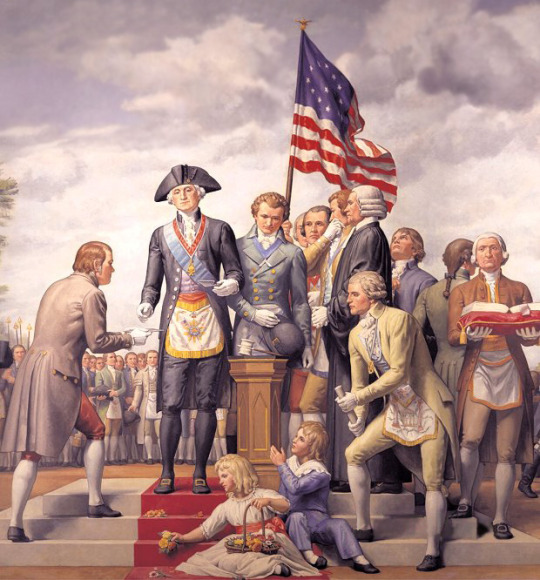
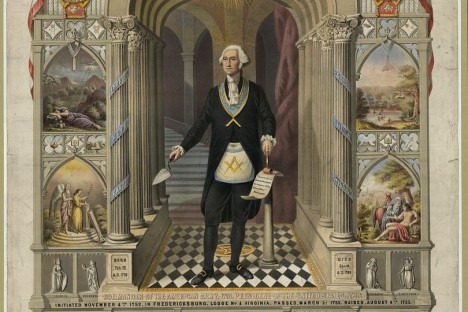
The Illuminati are said to be a group of globalist elite who secretly worship Lucifer, which is revealed in the highest degrees of Freemasonry, and rule the world systems using money.
From Biblical scripture, we can see Satan offered the worldly kingdoms to Christ Jesus if He would bow down to him:

On our United States money, there is a pyramid with the eye of Lucifer on the captstone, showing Lucifers' rule and dominion over the world systems. Under it reads Novus Ordo Seclorum. The motto Novus ordo seclorum can be translated as "A new order of the ages." It was proposed by Charles Thomson, the Latin expert who was involved in the design of the Great Seal of the United States.
We also see the words "Annuit Coeptis" which translates to "announcing the birth of." It seems this alludes to the Annoucing the Birth of the New World Order once the Capstone is in place, which I theorize represents the One World Leader - the AntiChrist who will soon appear as a false savior.



The Latin 'E Pluribus Unum' means 'One out of many' and probably refers to the AntiChrist rising out of many nations and people.
According to Manly P. Hall, a known 33° Freemason and member of the Illuminati indicated that this Eagle is rather a conventional Phoenix, which is known as the firebird of ancient pagan religions that causes destruction of itself in order to bring about a stronger self. This seems to coincide with the Freemason motto "Ordo Ab Chao" which means "Order out of Chaos."
https://www.watchmanalexander.com/blog/the-occult-symbolism-of-the-phoenix-part-1
According to Watchman Alex, Manly P Hall had a book titled Phoenix and revealed the following:
The legend of the phoenix got its start in ancient Egypt, where the bird was known as the bennu. As with many Egyptian ideas, the tale of the bennu passed into Greece and was restyled. As the Greeks tell it, the phoenix is a striking, eagle-like bird with brilliant purple feathers, and plumes of alternating red and blue in its tail. It is extremely long-lived and essentially immortal because it can resurrect itself at its time of death. Some say that the bird's former body opens up to reveal its new form, whereas others say that the bird consumes itself with fire before its new body can rise from the ashes. After recreating itself, the phoenix takes its nest, still filled with its own remains, and transports it to the city of Heliopolis to be burnt on an altar to the sun god, Helios/Ra.
These Luciferian puppets of the Illuminati and secret orders do the work of Satan for their own gain, and believe that through the ashes of destruction, the Antichrist will rise into power with the Final Beast System (Daniel 7). According to Bible prophecy, this will be the 7 years before Jesus returns to establish His Kingdom (Jude 1:14-15). This rise out of ashes is symbolized as the Rise of the Phoenix in the occult.
youtube
Lucifer - Fire and Ashes
In the below Old Testament passage, we see that the LORD used Ezekiel to send a message to the King of Tyrus, yet there is more to the story, a lot more. We can observe that the below passage is really a message to Lucifer, who was working through the King of Tyrus. We can say that because there is no way that the King of Tyrus was in the Garden of Eden, nor was he the most anointed Cherub who was banished from Heaven, that alone speaks of Lucifer:
Ezekiel 28:11-19 KJV - Moreover the word of the Lord came unto me, saying, [12] Son of man, take up a lamentation upon the king of Tyrus, and say unto him, Thus saith the Lord God ; Thou sealest up the sum, full of wisdom, and perfect in beauty. [13] Thou hast been in Eden the garden of God; every precious stone was thy covering, the sardius, topaz, and the diamond, the beryl, the onyx, and the jasper, the sapphire, the emerald, and the carbuncle, and gold: the workmanship of thy tabrets and of thy pipes was prepared in thee in the day that thou wast created. [14] Thou art the anointed cherub that covereth; and I have set thee so : thou wast upon the holy mountain of God; thou hast walked up and down in the midst of the stones of fire. [15] Thou wast perfect in thy ways from the day that thou wast created, till iniquity was found in thee. [16] By the multitude of thy merchandise they have filled the midst of thee with violence, and thou hast sinned: therefore I will cast thee as profane out of the mountain of God: and I will destroy thee, O covering cherub, from the midst of the stones of fire. [17] Thine heart was lifted up because of thy beauty, thou hast corrupted thy wisdom by reason of thy brightness: I will cast thee to the ground, I will lay thee before kings, that they may behold thee. [18] Thou hast defiled thy sanctuaries by the multitude of thine iniquities, by the iniquity of thy traffick; therefore will I bring forth a fire from the midst of thee, it shall devour thee, and I will bring thee to ashes upon the earth in the sight of all them that behold thee. [19] All they that know thee among the people shall be astonished at thee: thou shalt be a terror, and never shalt thou be any more.
In verses 18 and 19 of Ezekiel 28, we clearly see that YHVH God is telling Lucifer, the fallen angel and god of this world, that YHVH will send a fire to destroy him and all of his work will be ashes. We also know that at the end of the dispensation of the ages to come, the LORD will cast Lucifer into the fire for ever and ever:
Revelation 20:10 KJV - And the devil that deceived them was cast into the lake of fire and brimstone, where the beast and the false prophet are, and shall be tormented day and night for ever and ever.


I assume that Lucifer bitterly took this message from the LORD YHVH and made it into a prideful and rebellious religion of rebuilding kingdoms and nations after God sends judgment and justice by fire and ashes. In some cases, I believe Satan creates the chaos and fire himself to persuade the people into a new agenda or deception via Ordo Ab Chao, and God will allow it because the sins of the people. This has happened throughout the ages of the earth since the first sin by Adam and Eve in the Garden of Eden.
Satan also uses this Firebird motif to represent his spirit being reincarnated into the wicked rulers of the world, yet I believe those rulers and kings were just normal people who were fooled and possessed by Lucifer. Yet, it appears this is the Religious narrative of the Luciferians.
The False Messiah, Pagan Sun God, Phoenix
An article by the Gnostic Warrior purports the following information concerning the Pheonix or Bennu bird in relation to the Sun god Ra and his son.
• Gnostic Warrior Article
The Phoenix is one of the most sacred symbols to the brotherhood we know of as the Order of the Quest. It symbolizes the morning star who is the son of the sun, the father in which we celebrate through the rising of this most glorious fire-bird from the flames into immortality and reincarnation. The phoenix is the son and the messiah that has risen to become the soul of the Sun-God Ra.
This is represented today with the obelisk of the Porta del Popolo in Rome pictured to the right where we can find near the top an adoration of Ra with the words, ‘Rameses II, son of Ra, who rilled the temple of the Phoenix [ha-t-bennu] with his splendors.’ There is also seen in the Vatican on the wooden coffin of Hetepher-t-s a picture where it seen a hawk and a Phoenix with the words, ‘Glory be to Ra in the underworld!’ ‘Glory be to Ra when he rises!’
As Manly P. Hall said in his book, The Lost Keys of Freemasonry – “These were the immortals to whom the term ‘phoenix’ was applied, and their symbol was the mysterious two-headed bird, now called an eagle, a familiar and little understood Masonic emblem .”
It is in City of the Sun or in Greek, Heliopolis where the first written records were given to us by Herodotus in his work titled Euterpe had written how the Phoenix was first seen in Heliopolis during the reign of Sesostris and then in the reign of Amasis shortly after the days of Ptolemy. The most important temple in the City of the Sun at this time was the “Mansion of the Phoenix” or “Mansion of the Benben.” It has also been called the temple of the sun. In Utterance 600 of the Pyramid Texts speaks of Atum as you rose up, as the benben, in the Mansion of the Benu in Heliopolis (Hart, p.16).
In Heliopolis there in the middle of the Temple of the Sun stood an Obelisk with a capstone resting on top that was symbolic of the sun (son), the “Benben Stone” (pictured to the left). A stone obelisk is the material embodiment of the divinity of the Sun Ra, the Father, Zeu pater (“O, father Zeus”) or Saint Peter from the Greeks and Romans, because he was the father of gods and men. The holy of holies in his temple was called ” the house of the benben.” The cap stone is the son, or Ben. The name Ben signifies “son.”
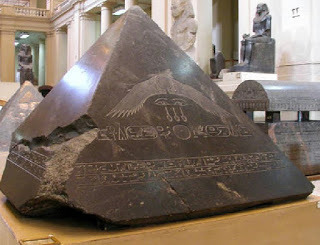
This is why many persons in both in the Old and New Testaments, are distinguished by the addition of the name “Ben” to that of their father in ancient times because they were the sons, AKA bright morning star of Venus and of the father, the Sun.
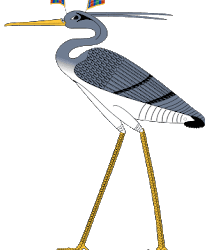
The Egyptian name of the Phoenix is bennu, from a root meaning ‘to turn/ so that the bennu signifies, as it were, the returning traveler. The Bennu bird serves as the Egyptian correspondence to the phoenix, and is said to be the soul of the Sun-God Ra. The Book of the Dead says, “I am the Bennu bird, the Heart-Soul of Ra, the Guide of the Gods to the Tuat” and other refrences to the Bennu bird such as “He Who Came Into Being by Himself,” “Ascending One,” and “Lord of Jubilees.”
So according to this article the Phoenix represents:
1. The son and the messiah that has risen to become the soul of the Sun-God Ra.
2. Immortals represented as two headed eagles which became the Freemason emblem.
3. The Sun Ra, the Father, Zeu pater (“O, father Zeus”) or Saint Peter from the Greeks and Romans, because he was the father of gods and men.
4. “He Who Came Into Being by Himself,” “Ascending One,” and “Lord of Jubilees.”
It seems all of these definitions could allude to the coming AntiChrist who I believe the Luciferians consider to be Tammuz, the son of Nimrod the Babylonian Sun god who impregnated Semiramis (Isis/Ishtar).
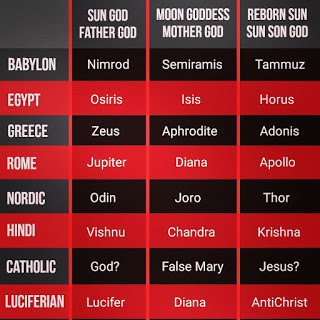
The AntiChrist I believe similar to the Phoenix will be birthed out of orchestrated death and destruction by the Globist Elite Luciferians and hence the Freemason Motto "Ordo Ab Chao".
The tip of the obelisk of Ra, known as the Capstone called "Benben Stone" is said to embody the blasphemous "divinity" of the sun god Ra and Zeus which is the false light of Lucifer. This Capstone is probably referenced on the US Dollar as you see the Eye of Horus or Eye of Lucifer shining upon his pyramid which is symbolic of his decieved kingdom on earth. When the Capstone sets on the Egyptian Pyramid, it probably alludes to the soon to appear AntiChrist, the reincarnated Sun god Ra (Tammuz, Zeus, Apollo, Nimrod, Etc.) who will be crowned and sit on his throne of deception as the New World Leader (Daniel 7 - Little Horn).

It also appears as though the Children of Israel at one point fell away from the Most High God of the Bible and began sacrificing their sons and daughters to the Pagan sun gods Baal/Moloch. Likewise, it seems Americans and lukewarm Christians do the same today without knowing it in the name of freedom (Lady Liberty/Ishtar):
Baal Canaanite Pagan Sun Diety
https://www.newworldencyclopedia.org/entry/baal
It seems that the blood of the innocent is a form of spiritual currency which advances Satan's Kingdom on earth and greatly grieves the LORD YHVH.
Modern Day Molech
By Charles Patrick on Jul 14, 2015
https://swbts.edu/news/releases/modern-day-molech/
"With the release of an undercover video today, the world learned, I hope, that a modern day Molech exists. Molech, as described in the Old Testament of the Bible, was an Ammonite god who required propitiatory child sacrifice. A couple sacrificed their firstborn by burning the child on a metal idol of Molech, believing that Molech would ensure financial prosperity for the family and future children. The Israelites were strictly forbidden to practice this form of worship (Leviticus 18:21, 20:2-5; 2 Kings 223:10; and Jeremiah 32:35) as it is in stark contradiction to the sanctity of life espoused throughout the Bible. Today’s Molech is the abortion industry, sacrificing babies for the idol of financial greed, veiled in the hopes of the development of new cures through biomedical research.
Biomedical research, like all the sciences, is ethically and morally neutral. The application of biomedical research, however, can be right or wrong. I have no problem with biomedical research in general. In fact, I had a previous 18-year career in biomedical research and can attest that the majority of biomedical research is ethically sound. However, basing bioethics on the truths of the Bible, abortion and the associated harvesting and selling of body parts from aborted babies is ethically, morally, and biblically wrong."
Osiris, Horus, and the Phoenix
It seems the Phoenix bird was also a motif in the ancient Egyptian culture although with small variations. The most prominent Sun god figure in Egypt was Osiris, who was said to be the incarnate form of the sun god. In the same manner as Nimrod and Tammuz, the spirit of Osiris was said to have been reincarnated or resurrected through his son Horus. This is a classic story of the pagan Father Sun god, Mother Moon god, and Son Sun god as the reincarnated form of the Father sun god. This is the pagan Trinity of the occult and pagan religions which is essentially Lucifer worship, the false sun god and false light (2 Corinthians 4:4) of the world.
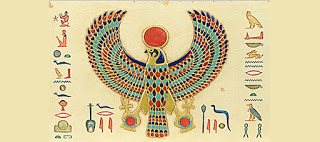
Horus is connected to the Egyptian sun God and the colorful falcon which is a symbol of ressurection and reincarnation of the pagan sun diety. It seems this colorful Horus falcon is likened to the Occult Phoenix or Bennu Bird.
https://www.ask-aladdin.com/egypt-gods/horus/
"Every pharaoh of Egypt is said to be an incarnation of Horus who as per legends is said to have conquered the evil god Seth in Upper Egypt. Seth is said to be the god of confusion and turmoil who killed Osiris who was the father of Horus. Horus in order to take revenge for his father’s death then became the god of justice and order. Thus the pharaoh Horus in ancient Egypt became Horus on earth who was the ruler of both upper and Lower Egypt. Horus is represented by the Hawk as the god of the sky. It’s a symbol of divine kingship and the protector of the one who is ruling."
It seems the famous "star" and now Luciferian songstress "Katie Perry" glorifies her father Lucifer by dressing as this colorful Horus Falcon which is a symbol of the pagan Sun god of Egypt. This appears to be analogous to the Phoenix or Bennu bird, and is a representation of the coming AntiChrist figure who the Luciferians believe was reincarnated and brought forth through the ashes of death and destruction.
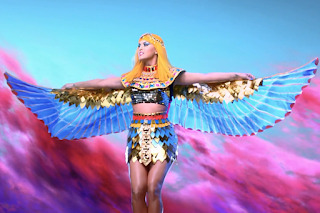

The Crown - The AntiChrist
The word "Corona" in Latin means a Crown, or a wreath-crown or garland. The interesting thing is that in the Book of Revelation the AntiChrist will recieve a Crown at his appearing, and will deceive the nations as a false Savior with a false peace covenant (a bow):
Revelation 6:2 KJV - And I saw, and behold a white horse: and he that sat on him had a bow; and a crown was given unto him: and he went forth conquering, and to conquer.
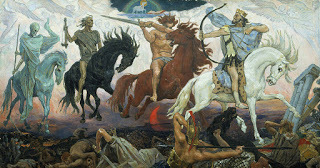
One fascinating historical fact is that many if not all of the major pagan leaders and Kings of ancient times, and perhaps even of recent times, have equated themselves with being an incarnation of a god if not the so called all powerful pagan sun god. We see in the below article from the encyclopedia that the Crown was associated with the pagan sun god:
https://www.encyclopedia.com/humanities/culture-magazines/crowns
"Along with height, some accessories on crowns also linked the wearer with the divine. The solar disk, for example, was often a central element of a crown and associated the wearer with the sun god, Re. The Uraeus-snake (cobra) was also often part of the crown and symbolized the sun god's eye. The god's eye represented the fire and radiance of the sun that consumed potential enemies. The Uraeus thus represented divine protection for the wearer."
The Crown is actually a physical representation of the shining light that emits from the face of the literal Sun in the heavens, as we observe the below pictures.


We also see a Center for Disease Control article also gives insight as to the link between the pagan sun gods and the deification of pagan kings and emperors, in relation to the Coronavirus appearance:

https://wwwnc.cdc.gov/eid/article/26/9/ac-2609_article
Our modern-day corona conceptualization of club-shaped spikes on the coronavirus surface comes from traditional representations of crowns as radiate headbands, worn as symbols of sovereign power, to liken that power to that of the sun. Solar deities have been integral in the development of cultures across the world. In predynastic Egypt, Atum was a solar deity associated with the sun god Ra, and Horus was the god of the sky and sun. In Buddhist cosmology, the bodhisattva (one who is on the path toward Buddhahood) of the sun, SūryaprabhaExternal Link, and the bodhisattva of the moon, Candraprabha, are both classically represented as human figures with a background of radiate halos. In traditional Western art, such a solar crown is often represented as a curved band of points representing rays. Representations with radiate crowns date from the 4th century BCE onward, beginning with their frequent inclusion in representations of Alexander III of Macedon (commonly referred to as Alexander the Great), who was likened to the sun deity, Helios (Figure 1)."
Furthermore, it is my understanding that the Luciferian Elite, perhaps since the ancient of days, have believed their rulers to be the physical incarnation of their pagan sun Diety. Therefore, it would only prove logical to assume they believe the final AntiChrist and One World Leader Revelation 13, is their pagan sun god reincarnated. We see this idea of the pagan sun god being reincarnated in the story of Nimrod and his son Tammuz as well as the Egyptian story of Osiris and his son Horus.
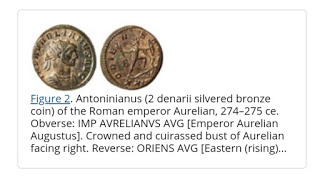
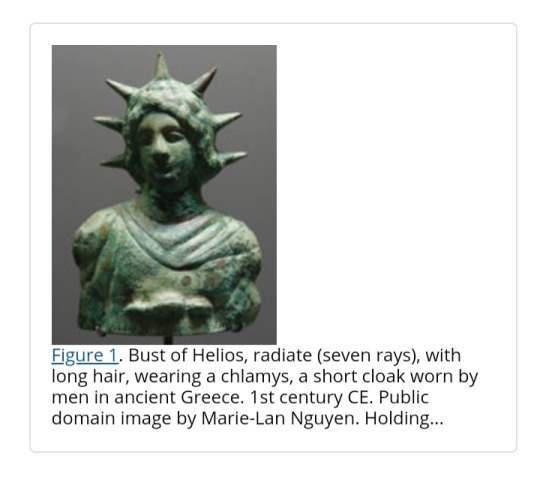
This idea of pagan rulers thinking they are the pagan sun god would fall in line with Bible prophesy as we see the AntiChrist who will soon appear will call himself the Most High God - which Christians know to be false because Jesus Christ is the Most High God and the only manifestation of God on the earth (John 1, Colossians 1, 2 Corinthians 5:19).
2 Thessalonians 2:3-4 KJV - Let no man deceive you by any means: for that day shall not come, except there come a falling away first, and that man of sin be revealed, the son of perdition; [4] Who opposeth and exalteth himself above all that is called God, or that is worshipped; so that he as God sitteth in the temple of God, shewing himself that he is God.
Therefore it seems the AntiChrist, as the false pagan sun Diety which I believe to be Lucifer himself, will rule the New World Order for the final 7 year period before Jesus returns to the earth to establish His Millennial Kingdom (Revelation 19-20).
Corona (Crown) Virushttps://docs.google.com/document/d/1sR-CEGtNG0q9a1waN2gZD8I23hfK3g9md2kPALuRl8A/edit?usp=drivesdk


Phoenix Mural - United Nations
According to Wikipedia (Article Here), the United Nations Security Council features a huge Phoenix Mural. The United Nations is AntiChrist in nature and is seeking global unity for the One World Order. It is interesting to note, the same symbolism of rising into a new age is presented in the Mural:
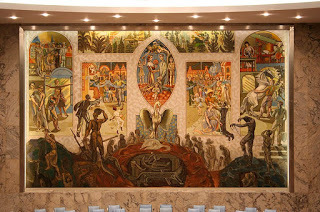
The artwork was commissioned by the Norwegian government as a gift from Norway to the United Nations. The mural is a 16 x 26 foot long canvas located on the Security Council's east wall and displays a central image of a rising phoenix. The phoenix is surrounded by images of war and disharmony near the bottom of the mural, and more tranquil images at the top. In 2013, Norway's Foreign Minister Espen Barth Eide, stated that Krohg's ambition "was to give the United Nations a chamber that could inspire those working in it to carry out the core of the United Nations mandate".
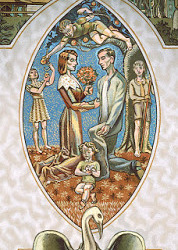
Through a vaginal shaped canal it seems we can see a peek at their "New Age of Luciferianism" that will be birthed by the coming of the AntiChrist and One World Order. It is a symbolic gesture of a golden age being birthed from chaos and death. It also seems to hint at the Nimord, Semiramis, and Tammuz pagan story, whereas, it seems the AntiChrist will be a sort of Nimrod reincarnated, the Tammuz which is the false light of the world (Revelation 6:1-2). It could also allude to the AntiChrist figure proposing to his Bride, the decieved and unsuspecting world who will worship the Beast (AntiChrist) and his image (Revelation 13). A union of deception and death in which will carry over to the Lake of Fire for eternity (Revelation 19-20).
This luciferian globalist's New World Order agenda is reiterated in another discription or commentary on the UN Security Council Phoenix Mural. Full article can be found here:
• Michael More Jones Commentary
Per Krohg’s painting is some five by nine metres, and is divided horizontally; the lower-third is executed in dark colours, the upper two-thirds much lighter with UN-white and blue motifs. Colour alone gives much of the work’s message: the lighter colours suggest peace, progress and truth, while the darker colours depict a hellish landscape. “Symbolising”, the UNSC tells us, “the promise of future peace and individual freedom”, the work shows a phoenix rising from a dark landscape into a light-filled world of progress. Though complex, with many panels depicting separate scenes, the painting’s overall message is simple: technology, justice and truth, united by the nuclear family and the UN-led world order, are forces that progress humanity.
The Bennu Bird (Phoenix)
http://m.landofpyramids.org/bennu.htm
Name: Bennu is the Egyptian word for Phoenix. The name 'bennu' derives from the Egyptian word “weben,” meaning “to rise brilliantly” or “to shine.”
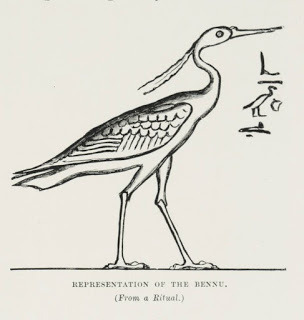
Description: The Bennu bird is described as resembling an eagle with beautiful red and gold feathers
Representation in art: The sacred Bennu bird is often represented in ancient Egyptian art as a heron, that is characterized by two long feathers streaming from the back of the head
Symbol: The Bennu (Phoenix) was was one of the most potent symbols of ancient Egypt symbolizing resurrection and the rising sun. It was also associated with the rising of the Nile
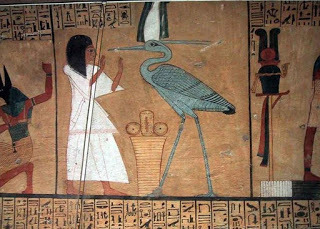

Significance: The sacred Bennu bird (Phoenix) destroys itself in flames and then rises from the ashes.
Sanctuary of the Bennu: The Bennu was located in the Sun Temple of Atum Ra at Heliopolis.
Phoenix Symbolism - Genki Sudo
We also see the former MMA fighter Genki Sudo who became the lead band member for the Japanese Band named "New World Order" came out with hits such as "Let's Start WW3" and has his part in the Occult symbolism of the Pheonix:
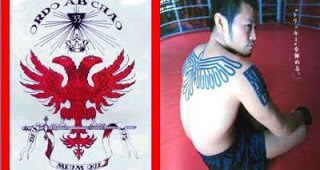
4 notes
·
View notes